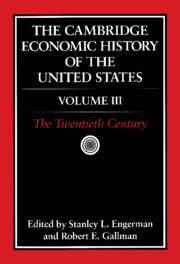Book contents
- Frontmatter
- 1 American Macroeconomic Growth in the Era of Knowledge-Based Progress: The Long-Run Perspective
- 2 Structural Changes: Regional and Urban
- 3 Twentieth-Century Canadian Economic History
- 4 The Twentieth-Century Record of Inequality and Poverty in the United States
- 5 The Great Depression
- 6 War and the American Economy in the Twentieth Century
- 7 U.S. Foreign Trade and Trade Policy in the Twentieth Century
- 8 U.S. Foreign Financial Relations in the Twentieth Century
- 9 Twentieth-Century American Population Growth
- 10 Labor Markets in the Twentieth Century
- 11 Labor Law
- 12 The Transformation of Northern Agriculture, 1910–1990
- 13 Banking and Finance in the Twentieth Century
- 14 Twentieth-Century Technological Change
- 15 The U.S. Corporate Economy in the Twentieth Century
- 16 Government Regulation of Business
- 17 The Public Sector
- Bibliographic Essays
- Index
- References
13 - Banking and Finance in the Twentieth Century
Published online by Cambridge University Press: 28 March 2008
- Frontmatter
- 1 American Macroeconomic Growth in the Era of Knowledge-Based Progress: The Long-Run Perspective
- 2 Structural Changes: Regional and Urban
- 3 Twentieth-Century Canadian Economic History
- 4 The Twentieth-Century Record of Inequality and Poverty in the United States
- 5 The Great Depression
- 6 War and the American Economy in the Twentieth Century
- 7 U.S. Foreign Trade and Trade Policy in the Twentieth Century
- 8 U.S. Foreign Financial Relations in the Twentieth Century
- 9 Twentieth-Century American Population Growth
- 10 Labor Markets in the Twentieth Century
- 11 Labor Law
- 12 The Transformation of Northern Agriculture, 1910–1990
- 13 Banking and Finance in the Twentieth Century
- 14 Twentieth-Century Technological Change
- 15 The U.S. Corporate Economy in the Twentieth Century
- 16 Government Regulation of Business
- 17 The Public Sector
- Bibliographic Essays
- Index
- References
Summary
INTRODUCTION
The expanding flow of funds that financed twentieth-century American economic growth was channeled by alternating waves of financial innovation and government regulation. At the beginning of the century, markets became more integrated as barriers to competition broke down. Yet the financial system was far from stable, and safety and soundness were the quest of public policy. The Federal Reserve System and the New Deal attempted to protect depositors and investors. They appeared to be successful because of subsequent periods of stability. Their limitations were revealed by the stock market crashes and banking crises of the Great Depression and the 1980s. Shaped by special interests, banking and financial reform built up a complex and burdensome regulatory regime. Over time, market pressures brought about the decline of traditional intermediaries and the rise of new institutions and markets. Only in the last twenty years, after inflation and recession battered the financial system did a thorough deregulation begin. Returning to pre—New Deal trends, distinctions between types of intermediaries have faded and financial markets have become more integrated and efficient.
THE FEDERAL RESERVE IN WAR AND PEACE, 1913–1929
In 1913 the Federal Reserve System was established to prevent banking crises. The Fed was a creature of late-nineteenth-century American banking, designed to correct its perceived weaknesses without changing its structure. Supervised by the Federal Reserve Board, the twelve Federal Reserve banks formed a new American “central” bank. To ensure long-term price stability, the Federal Reserve Act enshrined a gold standard rule of convertibility and enforced it by imposing gold reserve requirements for Federal Reserve notes and deposits.
- Type
- Chapter
- Information
- The Cambridge Economic History of the United States , pp. 743 - 802Publisher: Cambridge University PressPrint publication year: 2000
References
- 7
- Cited by



